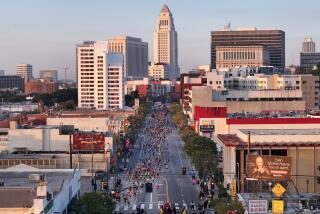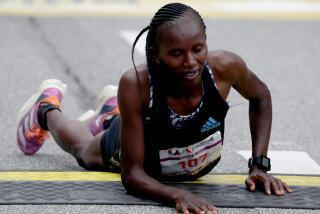A light load for 26.2 miles
- Share via
A week before the L.A. Marathon, you’re either in shape or not. You’ve done the training or not. At this point, there’s really just one thing that you can do to make yourself faster on race day, besides eating and sleeping well the night before: Show up at the starting line in lighter shoes. You’ll have to break them in first -- and yes, there’s still time (a couple of long runs should do the trick). But the lower weight can make turnover easier and reduce cumulative effort and fatigue, at least according to the math. An average runner takes around 160 steps per minute, and a top runner more than 180, says famed running authority Jack Daniels (the coach, not the drink), so a four-hour marathoner would take about 40,000 steps, plus or minus throughout 26.2 miles. And if marathon-day shoes weigh 3 ounces less than normal training shoes (as most of the 8- to 10-ounce shoes, in size 9, reviewed here probably do), well, then, each step is just that much lighter -- extra nice if you’re slower and take even more steps. The padded shoes below are not the bare-bones racing flats the elite wear, but they are light enough to have a positive impact on race times. Even if the effect is just psychological.
Roy M. Wallack
Barely there
Mizuno Wave Musha: Low-slung, minimalist 8-ounce mesh trainer.
Likes: Super light yet with some cushioning provided by Mizuno’s signature plastic wave-plate. Comfortable like a slipper but not as cushioned as the rest. Tactile forefoot, like the New Balance, but flatter in the back. Reptilian green color with sparkly black laces would look great at the after-race disco party.
Dislikes: Mid-pack heel strikers may not feel there is enough rear-foot cushioning.
Price: $120. (800) 966-1234; www.mizunousa.com.
Sole support for the long haul
Nike Skylon+ 11: Well-padded, 9.5-ounce racer.
Likes: Comfy in the long run. Far more padded than the other test shoes, the Skylon is not ultralight but still faster than normal. Though not optimal for trail running, I’d choose these for the marathon due to the cushioning. Wider than traditional Nikes, they fit my D-width well. Nice price, too.
Dislikes: The padding gives you less tactile feel and stability than the other shoes. Right away, you’re rocking more from side to side, although I got used to that in a few minutes on pavement.
Price: $90; www.nike.com.
No more untied laces
Zoot Energy: 10-ounce trainer with quick-lace system.
Likes: Built-in lace locks can’t come undone. Comfortable fit with asymmetrical neoprene band in the upper. Antimicrobial lining for those who like to run without socks.
Dislikes: While the shoe is comfortable and great for fast runners, the general lack of cushioning may become a factor for slower runners, especially heel strikers, after big miles.
Price: $110. (800) 241-9327; www.zootsports.com.
Nice Balance
New Balance 904: Roomy 9-ounce (in size 9) trainer with extra-light foam and some stability features.
Likes: Very comfortable. Despite a narrower, form-fitting shape than traditional New Balance shoes, my D-width forefeet didn’t complain. Your forefoot sits low, in a very tactile, ground-hugging position, with your heel locked in place above an inch of cushioning designed to keep heel strikers happy. Includes funky, undulating laces that supposedly don’t come untied easily. Has a stable feel. Also available in a trail runner.
Dislikes: None
Price: $110. (617) 783-4000; www.newbalance.com.
Wallack is the author of “Run for Life: The Anti-Aging, Anti-Injury, Super-Fitness Plan to Keep You Running to 100.”


